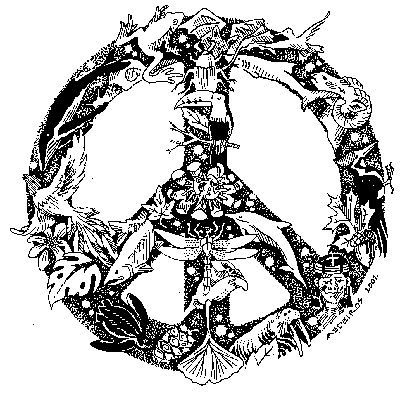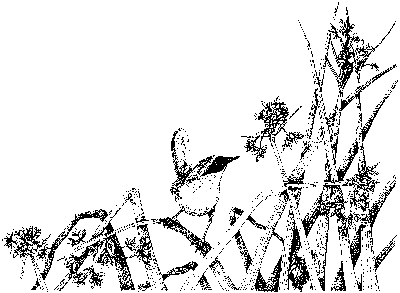


Living Lightly
By
LILLIAN VALLEE
22. When Food Came Up the Rivers
We have engaged in a
process of purposeful and
systematic forgetting; we have lost previous models
of a more elegantly balanced life among humans,
and we have convinced each other that it is
fruitlessly utopian to imagine any other way of life.
— Freeman House, Totem Salmon
A few years ago we were invited to attend a wedding near the Trinity River in northern California. The groom was Native American, and the highlight of the wedding was a salmon dinner, cooked the old way by young California Indian men who had learned from their grandfathers. They had whittled redwood stakes onto which they had skewered thick salmon steaks. The fire had been banked into a beautiful, glowing oval, and the stakes were tilted toward the heat then turned slowly so the fish would roast evenly. It was subtle, finely calibrated work, and the wild salmon delicious, yet the young men said they were amateurs in their efforts compared to their grandfathers.
Their grandfathers remembered a time when salmon ascended the rivers of the Northwest in astounding numbers (imagine sixteen million on the Columbia River alone), often crowding the watercourses from bank to bank. In his singular book about salmon, Freeman House retells an octogenarian neighbor’s stories about the fall run of king salmon on the Mattole River—the horses would refuse to cross because “the river had for a time become a torrent of squirming, flashing, silvery salmon light.” In House’s words, “…the arrival of salmon punctuated, at least once annually, a flow of provision that included acorn and abalone in the south, clams and berries and smelt in the north, venison and mussels and tender greens everywhere.” Salmon were a gift that came to people, to their villages, and their consumption was ritualized to make it thoughtful.
Anyone who has ever witnessed the migration of salmon to their spawning beds marvels at the timing and wonder of it all. Eggs hatch in safe, fresh water and develop hidden in gravel. The fry feed awhile in the river and try to stay alive. The smolts head back to the ocean, having undergone physiological changes allowing them to live in salt water, that is, to excrete excess salt. There in the ocean deep they graze, absorbing nutrients unavailable to them in their natal rivers. Finally, as adults, they smell their way back into those same natal waters and ascend in an epic journey during which they never eat again. Their flesh softens as they use up its nutrients; their energy goes into swimming against the current, hurling themselves over obstacles, and defending their nests. The adult salmon return to deposit their eggs or sperm; they return to deposit their bodies and to die.
Those who have seen the movements of the female creating a redd, her nest for the young she will never see, and who have observed the movements of the male arcing over the female to fertilize the young he will never see, refer to their movements as a dance. But the dance is not without a comic note: young yearling salmon, or “streaking jacks” as they are called in the trade, occasionally break into the dance in an attempt to fertilize the eggs. They have three times the sperm count of the mature adult males and always manage to create a little stir in an otherwise solemn spectacle.
The most surprising thing about salmon runs is how they benefit other animals and plants. This is House’s description of how, in death, salmon contribute to the health of riverine ecosystems:
Eagles, bears, raccoons, and otters have been patrolling the edges of the streams throughout the entire cycle; they feast and feast and feast. In this way a multitude of salmon bodies, carrying nutrients gained thousands of miles away in the depths of the sea, are carried away from the edge of the stream where they will also contribute (and contribute importantly) to the health and fecundity of the forest floor. Those carcasses that decompose in the water will feed microorganisms that will later feed salmonid offspring.
And in her book Water, Alice Outwater, explains how salmon contribute nutrients to plant life:
Anadromous fish are consumed by carnivores, like wolverines and eagles, and omnivores, like bears and people; and the plants benefit as well, because fish concentrate phosphorus, one of the critical nutrients for plant growth, in their bones. The fish-laden feces of larger animals and the offal and bones left on land once delivered a nutrient element that at present-day inland soils are often short of. When the spawning runs of fish declined, there was less flesh to sustain the meat eaters, and the green plants at the bottom of the food chain had less phosphorus to grow on, so the deer and elk had fewer new shoots to nibble on.
The concept of utter interdependence is expressed simply but gracefully in the Haida story “Salmon Boy.” The story teaches that salmon bones and other salmon parts that are not eaten must be returned to the river. The boy, who disregards the rules and shows disdain for the salmon, drowns and is taken to the world of The Salmon People. Here he sees that his disrespect cripples salmon children and makes them less than whole (an understanding that echoes what we know today about the nutrient cycle and how the offspring actually feed, indirectly, on the parents). The Salmon People will not sacrifice themselves for humans, he learns, if they are not accorded due ceremony and respect. The boy returns with the spawning salmon, is lifted out of the river by his mother, and becomes a teacher/healer to his people. His final realization is that the salmon is his journeying soul.
At a time when judges are deciding how much respect we need to accord the struggling Chinook salmon in the San Joaquin river watershed, these insights might help us speak out for wild salmon, a super food, a gift, emblem of struggle and sacrifice, emblem of some irreplaceable part of our journeying souls.
Sources: Michael J/ Caduto and Joseph Bruchac, ”Salmon Boy” in Keepers of the Animals; Lenore Feinberg & Terri Morgan, California’s Salmon Resource: Its Biology, Use and Management; Tim Ford, “Salmon of the Great Valley”; Freeman House, Totem Salmon; and Alice Outwater, Water.
Lillian Vallee is a Professor of Literature and Language Arts at Modesto Junior College.

![]()
Eating oil
By CAROLINE MITTON
How are food and oil related? Because oil is used in every step of our industrial-style food production, it can be said we are literally eating oil. We use oil to make fertilizer, to fuel farm machinery, to make plastic wraps and packaging, and finally to transport food. For every calorie of food we eat, probably ten or more calories of energy from oil have been used to produce it.
With oil becoming more expensive, it makes sense to look at our food-producing practices with the aim of reducing the various uses of oil. Organically-produced foods don’t use petroleum-based fertilizers. To save more oil, look for foods that are minimally-processed and packaged.
The typical food travels 1500 miles from where it is grown to our dinner table. A UK study found that almost half of the CO2 from a typical family’s activities was the result of shipping food. So, buy locally-produced foods. As a bonus, locally-produced foods have more nutrients — some are lost in the shipping. Another bonus is that we support our local farmers and our local economy — the money we spend stays here.
To find out more about our industrial-style agriculture and why the true cost of producing a pound of beef steak is $815, go to Elaine Gorman’s house on Wednesday, November 9 at 6 p.m. for a pot-luck, viewing of a short movie, and discussion about food production. The movie, The True Cost of Food, was produced by the Sierra Club Sustainable Consumption Committee. Indira Clark, a long-time Waterford sustainable farmer, will participate in the discussion.
ACTION: RSVP Elaine, 524-7630 or goford@sbcglobal.net.
![]()

![]()
Caswell State Park day hike
Enjoy leisurely stroll on Saturday, December 3 (about 5 miles) through our local State Park in the winter. There should be plenty of local and migrating birds that dwell in this remnant of valley riparian oak woodland habitat. We may see the salmon stragglers as they head upstream. A park ranger will accompany us. Bring binoculars, good hiking shoes, beverage, rain gear, and lunch. Heavy rain cancels. Meet at the downtown Stan. Co. Library at 8:30 AM.
ACTION: Contact Yokuts leaders Elaine Gorman at 524-7630 or goford@sbcglobal.net, or Dorothy Griggs at 549-9155.
![]()
